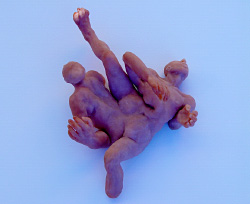Essay for “Protean Bodies”
Jenny Lynn McNutt
In Plato’s Symposium, the ancient Greek playwright, Aristophanes, tells the funny, sad, and anatomically curious story of the origin of desire. At first, there were three sexes: man, woman, and man-woman. All three were round and shaped like eggs: the man was the child of the sun, the woman of the earth, and the man-woman of the moon, which is made up of sun and earth. They had great physical strength, and god-like thoughts, and they aspired to rival the gods in strength and power. And so Zeus decided to cut them in half, increasing their number, but reducing their power. The result was that the man-woman, now divided into man and woman, desired to find he/she’s lost half. And this was the same with the man and the woman, the man desiring to find his lost male counterpart, the woman her female one. Sexual difference was born, longing and desire became one of the central facts of our existence, and the pleasure of union with a lost other has become one of the myths we live by—a myth we embody in our attachments to lovers, friends, parents, and children; and in our ethnic and national affiliations.
In response to Aristophane’s version of these attachments,
Jenny Lynn McNutt’s highly stylized, but beautifully modelled, anatomically precise sculptures and prints present subtle challenges to the ancient Greek’s story. In her work, male and female and male/female bodies join together in various configurations: in one image, a female body is joined at the neck to a male body, so that the female body takes the place of the man’s head, and the male body takes the place of the woman’s head. This strange, new creature seems to be hurtling through space, unmoored from all myths, especially the reassuring myth that union with others guarantees our happiness, both as individuals and social beings. And yet these figures aren’t simply reflexive images of post-modern skepticism and doubt. The modeling of the musculature is heroic; the acrobatic grace of these bent-backed bodies reveals the artist’s empathetic understanding of the human body’s capacity for pain and pleasure. Finally, the digital manipulation of the images contrasts brilliantly with the low-tech, anatomical fidelity of the artist’s modelling. The almost operatic tension and strain of these headless figures’ flight through the void is balanced by a sense of technological cool.
But it isn’t quite precise to call these figures headless: the head as the seat of reason and rationality, but also of dream and imagination, has been plunged into the interior space of the other’s body: the literalness of McNutt’s depiction of how it feels to be inside another person’s bodily, interior reality gives these figures astonishing dignity, vulnerability, and poignance. These bodies’ meteor-like plunge through the digital void makes them seem on the verge of bursting into flame, breaking apart at the neck, separating forever. But again, the void that threatens these figures isn’t really a void, it’s a form of technolgical manipulation. McNutt’s skill in the traditional art of modeling may allude to the heroism of a Michelangelo—the body thrown alive into the air, caught in the full-throttle grip of being and becoming—but her digital savvy tempers the high drama, and serves as a corrective to seeing these images in overly personal or merely psycholgical terms.
So in addition to McNutt’s bravery in exploring her own private psychic spaces, her imagery has profound social implications: how one person connects to another becomes the basis of a politics founded on erotic attraction, desire for autonomy, and the constant negotiations that ensue, both private and social, when we plunge our heads into the body of a lover or the body politic. McNutt’s way of seeing the body plunging through a void, stripped naked, is a beautiful illustration of the unaffiliated fact of the human body. But this stripped bare fact is powerfully countered by the artist’s means of producing images, which conjures up the connective web of our computerized world. Given the political climate of our day, McNutt’s intuitive critique of Aristophanes’ story makes us feel three things: the difficulty of having a body; the problem of wanting another body to complete our own body; the need for constant, mutual negotiations to make sure that the wish for completion doesn’t devolve into a desire to dominate and coerce—and this is as true of lovers as it is of nations. No other artist of our day has captured with such fidelity, intelligence, and deep-founded empathy the problem of being two, and of trying to remain two, while wanting, or being pressured, to merge into one.
—Tom Sleigh,
writer and professor of writing,
Hunter College, NYC
June 2005
Archive: Essays

Circe’s Body, Polymer, 2005